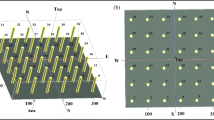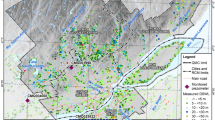Abstract
Spatial data analytics provides new opportunities for automated detection of anomalous data for data quality control and subsurface segmentation to reduce uncertainty in spatial models. Solely data-driven anomaly detection methods do not fully integrate spatial concepts such as spatial continuity and data sparsity. Also, data-driven anomaly detection methods are challenged in integrating critical geoscience and engineering expertise knowledge. The proposed spatial anomaly detection method is based on the semivariogram spatial continuity model derived from sparsely sampled well data and geological interpretations. The method calculates the lag joint cumulative probability for each matched pair of spatial data, given their lag vector and the semivariogram under the assumption of bivariate Gaussian distribution. For each combination of paired spatial data, the associated head and tail Gaussian standardized values of a pair of spatial data are mapped to the joint probability density function informed from the lag vector and semivariogram. The paired data are classified as anomalous if the associated head and tail Gaussian standardized values fall within a low probability zone. The anomaly decision threshold can be decided based on a loss function quantifying the cost of overestimation or underestimation. The proposed spatial correlation anomaly detection method is able to integrate domain expertise knowledge through trend and correlogram models with sparse spatial data to identify anomalous samples, region, segmentation boundaries, or facies transition zones. This is a useful automation tool for identifying samples in big spatial data on which to focus professional attention.











Similar content being viewed by others
Availability of Data
The datasets generated during the current study will be publicly available on the corresponding author’s GitHub Repository: whenn0406/Repeatable-Research-Workflow upon publication.
References
Byers SD, Raftery AE (1998) Nearest neighbor clutter removal for estimating features in spatial point processes. J Am Stat Assoc 93:577–584
Chandola V, Banerjee A, Kumar V (2009) Anomaly detection: a survey. ACM Comput Surv 41(3):1–58
Delaunay B (1934) Sur la sphère vide. A la mémoire de Georges Voronoï. Bulletin de l’Académie des Sciences de l’URSS Classe des sciences mathématiques et na 6:793–800
Deutsch CV, Journel AG (1997) GSLIB geostatistical software library and user’s guide, 2nd edn. Oxford University Press, New York
Isaaks EH, Srivastava RM (1989) An introduction to applied geostatistics. Oxford University Press, New York
Journel AG, Huijbregts CJ (1978) Mining geostatistics. Academic Press, New York
Journel AG, Posa D (1990) Characteristic behavior and order relations for indicator variograms. Math Geol 22:1011–1025. https://doi.org/10.1007/BF00890121
Pyrcz MJ, Deutsch CV (2014) Geostatistical reservoir modeling, 2nd edn. Oxford University Press, New York
Shekhar S, Lu CT, Zhang PS (2001) Detecting graph-based spatial outliers: algorithms and applications (a summary of results). In: Proceedings of the seventh ACM SIGKDD international conference on knowledge discovery and data mining, San Francisco, pp 371–376
Sun P, Chawla S (2004) On local spatial outliers. In: Proceedings of 4th IEEE international conference on data mining, pp 209–216
Sun P, Chawla S (2006) SLOM: a new measure for local spatial outliers. Knowl Inf Syst 9(4):412–429
Xiao H (1985) A description of the behavior of indicator variograms for a bivariate normal distribution. M.Sc. thesis, Branner Earth Sciences Library, Stanford University
Acknowledgements
The authors sincerely appreciate the financial support from DIRECT Industry Affiliates Program at the Hildebrand Department of Petroleum and Geosystems Engineering, University of Texas at Austin.
Funding
This research was supported by the DIRECT Industry Affiliates Program at Hildebrand Department of Petroleum and Geosystems Engineering, University of Texas at Austin.
Author information
Authors and Affiliations
Corresponding author
Ethics declarations
Conflict of interest
The authors declare that they have no known competing financial interests or personal relationships that could have appeared to influence the work reported in this paper.
Rights and permissions
About this article
Cite this article
Liu, W., Pyrcz, M.J. A Spatial Correlation-Based Anomaly Detection Method for Subsurface Modeling. Math Geosci 53, 809–822 (2021). https://doi.org/10.1007/s11004-020-09892-z
Received:
Accepted:
Published:
Issue Date:
DOI: https://doi.org/10.1007/s11004-020-09892-z




